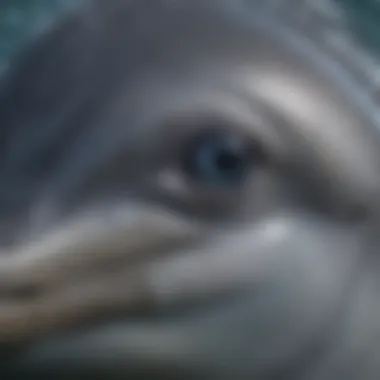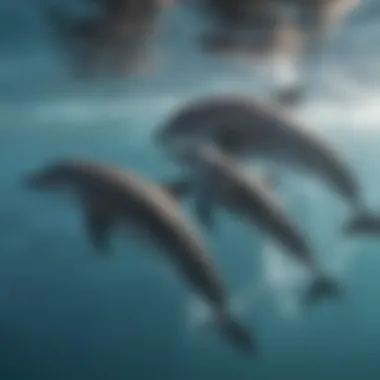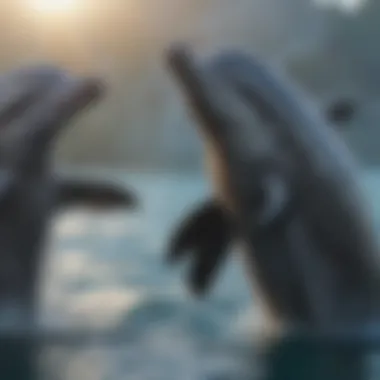Explore the Fascinating Characteristics of Bottlenose Dolphins


Nature Topic Overview
Bottlenose dolphins are among the most recognizable marine mammals. This article explores their unique characteristics, behaviors, and social structure. Their intelligence and adaptability make them fascinating creatures in the ocean. By better understanding these dolphins, young minds can develop an appreciation for marine life.
Fun Facts and Trivia
Did you know that bottlenose dolphins can recognize themselves in mirrors? Here are a few more fun facts:
- They can hold their breath for up to 15 minutes.
- Each dolphin has a unique whistle, acting like their name.
- These dolphins are known for engaging in playful behaviors, often riding waves.
Adding visuals or diagrams can enhance the learning experience for children. Consider using pictures of dolphins swimming, socializing, and playing.
Wildlife Explorations
Bottlenose dolphins belong to a larger family known as Delphinidae. Within this family, there are approximately 37 species of dolphins. One well-known relative is the Orca, also called the killer whale, which shares some common traits. In addition to dolphins, marine environments host various animals, including sea turtles and colorful fish. Providing quizzes about these related species can make learning interactive and engaging.
Environmental Awareness
Conservation of marine life is crucial. Bottlenose dolphins face threats such as pollution and habitat loss. Awareness helps us protect these creatures. Simple actions can make a difference:
- Reduce plastic usage.
- Support local conservation groups.
- Educate peers about dolphin benefits to ocean ecosystems.
DIY Nature Activities
Engaging with nature fosters connection. Here are some hands-on activities:
- Dolphin art: Draw or paint your interpretation of a bottlenose dolphin.
- Storytime: Read a book about dolphins or write your own dolphin adventure.
- Beach clean-up: Organize a small group to clean a local beach, observing nature.
These activities encourage creativity and responsibility toward the environment. Exploring practical applications of learned concepts reinforces their understanding.
"Every action matters when it comes to preserving our ecosystems."
Intro to Bottlenose Dolphins
The Importance of Studying Dolphins
Studying dolphins, especially bottlenose dolphins, is critical for various reasons. These marine mammals are intelligent and exhibit behaviors that fascinate both researchers and the general public. Their ability to communicate, socially interact, and adapt to different environments suggests a complexity worthy of examination. Additionally, understanding dolphins contributes to our knowledge of marine ecosystems. By observing their roles, we can gain insights into ocean health. Conservation efforts rely on this understanding to protect these species and their habitats. Therefore, studying dolphins promotes a broader awareness of environmental stewardship and wildlife conservation.
Bottlenose Dolphins: An Overview
Bottlenose dolphins are truly remarkable species. They inhabit warm coastal waters around the world. These dolphins possess a well-defined social structure, usually living in groups called pods. A pod can consist of just a few individuals or hundreds of them.
In terms of physical characteristics, bottlenose dolphins are well-known for their distinct features. Their streamlined bodies allow them to swim swiftly. They are generally gray with lighter underbellies, contributing to their camouflaged design in the ocean.
One could say bottlenose dolphins are not just creatures of curiosity; they reflect the health of their marine environments. Their behavior often indicates changes in ocean conditions, making them key indicators for marine scientists. Additionally, their interaction with other marine life plays a significant role in ocean ecosystems. As they flourish, so too can ocean health, making their study fundamentally crucial for both biodiversity and conservation purposes.
Physical Characteristics of Bottlenose Dolphins
Understanding the physical characteristics of bottlenose dolphins is crucial for comprehending their adaptability and survival strategies. These traits not only facilitate their interactions in marine environments, but also influence their ability to navigate and communicate. Each feature contributes uniquely to their behaviors and social structures. Studying these aspects is essential for the conservation of the species and enhances our appreciation of these incredible animals.
Size and Structure
Bottlenose dolphins are medium to large sized marine mammals that usually weigh between 300 to 1,400 pounds. Their length can range from 8 to 12 feet, with males often being larger than females. This size enables them to thrive in various oceanic environments. The body is aerodynamically shaped, aiding in swift swimming. Strong muscles support their remarkable agility in water. Additionally, the structure of their skeleton is adapted for flexibility and movement, allowing them to leap and engage in acrobatics.


Skin and Coloration
The skin of bottlenose dolphins is smooth and rubbery. This aids in reducing drag as they swim. Usually, they present a grayish hue that can lighten or darken depending on their habitat. The coloration helps them blend into the ocean waters against both predators and prey. Sunlight reflection plays a part in how their skin tone appears. Their undersides are typically lighter than their backs, which aids with camouflage when viewed from above. This countershading is a vital aspect of their evolutionary benefits in avoiding detection.
Distinctive Features
Distinctive characteristics help in the identification of bottlenose dolphins and speak volumes about their adaptations. Notable features include their beak structure and dorsal fin.
Beak Structure
The beak structure of a bottlenose dolphin is noteworthy socially and functionally. It is elongated and streamlined, which assists in hunting. This adaptation enables them to capture fish effectively. The length of the beak also plays an essential role in their acoustic communication methods. Dolphins use clicks and whistles that can vary in modulation, helping range the distance during that exchange.
Moreover, the beak contributes to the dolphin's “sonar-like” ability, allowing them to detect objects and navigate securely. Given this unique design, the beak becomes crucial for hunting and interacting with various species.
Dorsal Fin
The dorsal fin of bottlenose dolphins is distinct in its triangle shape. This fin aids in stability during swimming and is crucial for identification among individuals. The position of the dorsal fin also plays a role in regulating their swimming speed. Those fins can provide balance while they leap and perform playful actions. Additionally, thanks to the location of the dorsal fin, it can help observers detect their movements in water, serving as a visible pinpoint while they swim above and below the surface.
The strength and shape of the dorsal fin vary depending on age and health, indicating social standing and health condition. These variations can have significant implications in their interactions within pods.
In learning about bottlenose dolphins’ physical traits, we obtain a greater comprehension of how evolution has shaped these beings for aquatic life.
Behavioral Traits of Bottlenose Dolphins
Understanding the behavioral traits of bottlenose dolphins is key to comprehending their roles in the marine environment. Dolphins are known for their intelligence and social behaviors. These mammals exhibit complex interactions that reflect their cognitive abilities. Observing these behaviors provides insights into their lives and makes it possible to formulate effective conservation strategies.
Communication Methods
Dolphins have sophisticated means of communication, which include vocalizations and body language. These methods are vital for maintaining social bonds and coordinating activities within pods.
Vocalizations
Vocalizations of bottlenose dolphins involve a range of sounds, from clicks to whistles. This variety is essential for communicating both in playful situations and during serious discussions like hunting. Their ability to produce different sounds highlights their intelligence.
One key characteristic of vocalizations is their flexibility. Dolphins can change sounds based on necessity, making it an effective way to relay various sentiments or information. This option makes vocalizations a primary choice for interactions within their communities.
An unique aspect is their ability to mimic sounds, not only each other but also outside noises like human-made sounds. This aspect can lead to advantages in adapting to changing environments, but it may also present disadvantages, like miscommunication.
Body Language
Body language plays a critical role in the social dynamics of bottlenose dolphins. It involves physical movements such as leaps, spins, and postures. Massive slaps of the tail, for example, can indicate excitement or alert others to potential dangers. This type of communication complements vocalizations.
The diversity in body language allows dolphins to express their intentions and emotions. Given the subtle nature of some movements, understanding body language requires careful observation. This makes it a popular subject for researchers studying dolphin interactions and social standings.
A special characteristic is that these movements can convey quickly shifting emotions. This immediacy helps enhance social connections, but it also may create misunderstandings if the signals are misread.
Hunting and Feeding Habits
Bottlenose dolphins are skilled hunters. They often work in groups, using methods like herding to ensure the successful capture of aquatic prey such as fish and squid. Coordinated movements display their behavioral complexity. This teamwork underlines vital aspects of their social structures.
The hunting techniques they exhibit reflect a deep understanding of both their environment and prey behavior. Such insight is integral in ensuring food availability in changing conditions.
Play and Social Interaction
Play is an essential component of a dolphin's behavior. It is vital for young dolphins to develop social skills necessary for life in their communities. Dolphins are often seen surfing on waves or splashing around each other in playful exchanges.


Social interaction ensures that bonds within pods remain strong. Gestures and habits exhibited during play help solidify these connections. Understanding these traits fosters greater appreciation for the intricacies of dolphin life in the oceans.
Notably, both play and serious interactions shape their experience in larger ecosystems, contributing to their intelligence and adaptability.
Social Structures and Family Dynamics
Social structures and family dynamics are crucial in understanding bottlenose dolphins. These elements shape their behavior and influence their survival strategies. By exploring how these dolphins form social groups and interact within kinship relationships, we can gain insight into their lives. Such information increases our understanding of marine ecosystems and the importance of social interactions among animals.
Pod Formation
Bottlenose dolphins often live in social groups known as pods. Pod sizes can range from just a few dolphins to over a hundred. The composition of these pods can change frequently, depending on factors such as hunting patterns and environmental conditions. Within a pod, dolphins form strong social bonds.
- Members within a pod work cooperatively. This cooperation is essential while hunting for fish or maintaining group safety.
- Each pod has its own dynamic. The relationships can be friendly or even competitive at times. Such interpersonal dynamics are crucial for their survival in the wild.
An intriguing aspect of their social behavior is how young dolphins learn from older individuals in their pods. The younger members observe as their elders demonstrate skills. This method of social learning plays an important role in shaping their future interactions.
Parent-Child Relationships
Parent-child relationships in bottlenose dolphin pods are significant. Dolphins exhibit strong maternal care. A mother will stay with her calf for an extended period, nurturing it until it is independent enough to survive alone.
- The bond between mother and calf is informative for the young dolphin. Learning occurs in various forms, such as hunting techniques and communication signals.
- Mothers often use specific vocalizations to communicate with their calves. This helps in maintaining connection even in the busy waters of the ocean.
Once the young become older, they may remain associated with their mothers or continue to engage with the pod. These ongoing relationships are vital in the social structure of dolphins. Studies highlight that these social ties not only strengthen family bonds but also contribute to the pod's overall cohesion.
Understanding the social structures and family dynamics of bottlenose dolphins provides a window into their complex relationships and ensures their survival in our changing oceans.
Habitat and Distribution
The habitat and distribution of bottlenose dolphins are critical factors in understanding their behavior and ecology. Recognizing where these dolphins thrive gives insight into the environments that sustain marine life. This section explores preferred environments and global distribution, offering vital information on how these mammals navigate their world.
Preferred Environments
Bottlenose dolphins commonly inhabit coastal waters, such as bays, lagoons, and estuaries. These environments are usually shallow, allowing for easy access to food. The dolphins are also seen in deeper ocean waters where prey like fish and squid is more plentiful. Factors influencing their habitat preferences include:
- Water temperature: Bottlenose dolphins favor warm waters, typically ranging from 15 to 25 degrees Celsius.
- Salinity: They are found in saltwater but can also adapt to brackish waters, where freshwater mixes with ocean water.
- Habitat Structure: Rocky areas with ample nooks provide hunting advantages as dolphins can sneak up on prey.
Bottlenose dolphins can also exhibit a distinctive pattern in habitat selection based on prey availability, social dynamics, and environmental conditions. Changing sea temperatures or pollution might also influence where they choose to stay.
Global Distribution
The bottlenose dolphin has a broad global distribution. They can be found in a variety of seas and oceans from tropical regions to temperate areas. Key points about their distribution include:
- North Atlantic Ocean: Bottlenose dolphins populate both sides of the ocean., They are sights from the Caribbean to the coastlines of Europe.
- North Pacific Ocean: Similarly, sightings occur from the coasts of North America to Japan and Australia.
- Mediterranean Sea: Here, populations flourish mostly due to the abundance of fish.
- Other Locations: They are also present in coastal waters of southern Africa, parts of South America and pockets of the Indian Ocean.
The widespread distribution aids in understanding how bottlenose dolphins connect with marine ecosystems across different regions, emphasizing conservation needs in varying environments.
Being adaptable species, bottlenose dolphins demonstrate remarkable flexibility regarding their locations according to food availability and environmental conditions. Mapping their habitat is crucial for conservation initiatives and ensuring their survival.*, Identifying these aspects assists researchers and conservationists in creating effective strategies to protect both the dolphins and their habitats.
Intelligence and Problem Solving
Understanding the cognitive strengths of bottlenose dolphins reveals much about their behavior and adaptability. Their intelligence manifests in several ways that enable them to thrive in diverse marine environments. This section will explore their cognitive abilities and how these contribute to problem-solving skills, showing why these mammals are viewed as some of the smartest in the ocean.
Cognitive Abilities


Bottlenose dolphins possess advanced cognitive skills that place them at the top of the aquatic intelligence scale. Their brains are large relative to their body size, indicating complex processing capabilities. Scientific studies have shown they can recognize themselves in mirrors. This self-awareness is often a sign of high intelligence.
Communication plays a significant role in their cognitive abilities. Dolphins use a range of sounds and body gestures, enabling them to discuss ideas or plans within their pods. For example, they can coordinate group movements when hunting or evading predators. Their memory also plays a vital role; they can remember locations and experiences, helping them navigate vast ocean waters effectively. This has significant implications during hunts or mating.
Bottlenose dolphins’ cognitive abilities not only showcase their intellect but also their social nature. They can solve complex problems together, which strengthens pod unity.
Learning and Adaptation
Bottlenose dolphins exhibit remarkable learning attributes that allow them to adapt to new situations and environments. They can learn through imitation and experience, making them resilient in changing ocean conditions. When observing other dolphins perform tasks, they can quickly pick up similar skills themselves.
In captivity, trainers have demonstrated that dolphins can follow commands after only a few repetitions, highlighting their capacity to learn. Beyond formal training, dolphins display an understanding of tools; for instance, some have been observed using marine sponges to protect their snouts while searching for food on the ocean floor. This kind of innovation is a testament to their skilled problem-solving capabilities.
Furthermore, adaptation extends beyond mere skills. Bottlenose dolphins can modify their hunting techniques based on their environment, showing their ability to change strategies quickly when needed. This dynamic learning process enhances survival and expands their potential for interaction with other marine species.
Conservation Status
Understanding the conservation status of bottlenose dolphins is key to ensuring their survival in our oceans. This aspect touches on vital topics such as habitat protection, population health, and necessary conservation measures. Awareness and insights regarding the Conservation Status not only inform us about current issues but also guide us in future conservation initiatives. It becomes clear that taking care of these dolphins contributes to a healthier marine ecosystem overall.
Threats to Bottlenose Dolphins
Bottlenose dolphins face a variety of threats that can impact their populations and well-being. Some prominent threats include:
- Habitat Destruction: Coastal development and marine pollution harm their breeding and feeding grounds. Poor water quality and loss of vital habitats diminish the dolphins’ swimmimg space and available resources.
- Commercial Fishing: Dolphins can get accidentally caught in fishing nets, a troubling issue known as bycatch. Some fishing strategies may unintentionally trap them, resulting in injury or death.
- Climate Change: Increasing ocean temperatures and changing currents can alter food availability. Bottlenose dolphins depend strongly on fish. If fish migration patterns change, it could affect the dolphins' food supply.
- Acoustic Pollution: Submarine noise pollution from ships and ocean exploration can disorient bottlenose dolphins. Their communication relies heavily on echolocation, and excessive noise can hinder these abilities, reducing their effectiveness in hunting.
By recognizing and tackling these threats, we can make a difference in the lives of bottlenose dolphins.
Conservation Efforts and Initiatives
Various conservation efforts and initiatives are ongoing to support bottlenose dolphins and their habitats. Notable examples include:
- Protected Marine Areas: Establishing no-fishing zones or marine sanctuaries helps safeguard critical dolphin habitats. These areas are established to ensure that dolphins can freely swim and reproduce without threats from human activities.
- Research and Monitoring: Conservation organizations track dolphin populations, health, and behavior. This research enhances our understanding and provides vital data to inform management plans.
- Fishing Regulations: Enforcing stricter fishing guidelines helps reduce bycatch risks. Programs designed to enhance best practices among fishermen aid dolphins and long-term fishing sustainability.
- Public Awareness Campaigns: Many initiatives aim to educate the public about bottlenose dolphins, highlighting their ecological importance. When people understand dolphins’ significance, there’s a greater likelihood they will engage in conservation actions.
Continued attention to these efforts increases the chance that bottlenose dolphins can thrive in their natural habitats. Thus, reinforcing the importance of collaborations between communities, scientists, and policymakers is critical. Each well-considered action can make a substantial difference for these remarkable marine creatures.
Culmination
Bottlenose dolphins play a significant role in the ocean ecosystem, serving as indicators of environmental health. Their activities can reveal changes in marine ecosystems due to pollutants or climate change. Understanding their role helps both scientists and the public recognize the importance of maintaining the balance of marine life. Moreover, as we study these creatures, we also uncover more about our interactions with the ocean, which is vital for our own survival.
The Role of Bottlenose Dolphins in Ecosystems
Bottlenose dolphins contribute to biodiversity in several ways. First, they help regulate fish populations by hunting various species, which maintains food web balance. Their existence also supports tourism and education in coastal areas, prompting efforts to conserve marine environments.
Researchers observe dolphins because they can provide insight into oceanic health. If bottlenose dolphins thrive, it often indicates a clean, well-balanced ecosystem. Conversely, if these dolphins are struggling, it can signal deeper environmental issues that need attention.
Key roles of bottlenose dolphins:
- Predators of fish, controlling aquatic species populations
- Indicators of overall sea health
- Engagers of the local economy through ecotourism
Encouraging Environmental Awareness
Educating children and adults about bottlenose dolphins fosters a sense of responsibility towards the ocean. When people understand the significance of these animals, they are more likely to participate in conservation activities.
Effective ways to encourage awareness include:
- School Programs: Teaching about dolphin behavior and habitat helps cultivate interest in marine biology.
- Community Activities: Getting involved in beach cleanups or local marine conservation programs promotes hands-on learning.
- Digital Resources: Utilizing platforms like en.wikipedia.org or britannica.com for information sharing engages a wider audience.
“Understanding marine life is crucial to protect our oceans and all who call it home.”
Efforts to raise awareness can lead to positive changes in behavior regarding pollution and plastic use, which affects dolphins and their environment.
Through collective action and education, we can help ensure the future of bottlenose dolphins and healthier oceans for generations to come.







